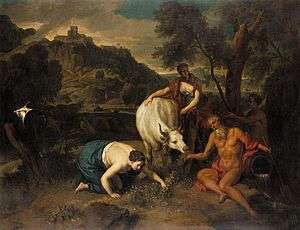Victor Honoré Janssens

Victor Honorius Janssens or Victor Honoré Janssens or Jansens) (11 June 1658 - 14 August 1736) was a Flemish painter of religious and mythological works and a tapestry designer.
Life
Janssens was born in Brussels as the son of a tailor. He studied design and was entered as a pupil in the register of the Brussels Guild of Saint Luke in 1675.[1] He left at some point for Italy. Estimates for the length of his residency in Italy vary from roughly 1680 to 1688 and 1678 to 1689.[2][3] Upon his return to Brussels he became a master of the Guild.[1] The next year he applied for permission to work as a cartoon painter for the Brussels tapistry works.[3]
Following the 1695 Bombardment of Brussels by the French, Janssens was commissioned to produce a number of paintings for the Brussels Town Hall to replace those destroyed during the attack on the city. He also worked for the local guilds and churches.[3] He gained a solid reputation and became well-off. He was appointed the court painter of Emperor Charles VI of Austria and resided in Vienna from 1719 to 1722.[1][2]
The artist died in Brussels on 14 August 1736.[2]
Work

Janssens' principal works are the series of paintings which he produced for the Brussels Town Hall. He was mainly a painter of historical subjects. His style reflects trends in Italy of the late 17th century and a classical bias.[1][3]
Two sets of cartoon series he produced for the Brussels tapestry workshops are recorded. A first commission in 1711 from the workshop of the brothers Urbanus and Daniel II Leyniers involved the painting of six designs in oil on canvas on Greek history themes and was later referred to as 'Famous men from Plutarch'. The Leyniers brothers' workshop merged in 1712 with that of their cousin Hendrik II Reydams, which took over the cartoons. The number of cartoons was increased to 8 in 1715 and to eleven in 1734. Various editions of the tapestries have survived. Janssens executed the designs according to the fashion for classicist history painting and he developed the themes in wide and balanced compositions.[3] The series shows Janssens' mature synthesis of historical and monumental painting.[4] This series established Janssens' reputation as a designer of tapestries and he received in 1716 a commission from the States of Brabant to make designs for a series of tapestries on the history of the Duchy of Brabant. The designs were realised by the Leyniers-Reydams workshop the next year and still adorn the Brussels Town Hall.[3]
References
| Wikimedia Commons has media related to Victor Honoré Janssens. |
- 1 2 3 4 Paul F. State, 'Historical Dictionary of Brussels', Rowman & Littlefield, 16 Apr 2015
- 1 2 3 Victor Honoré Janssens at the Netherlands Institute for Art History (Dutch)
- 1 2 3 4 5 6 Guy Delmarcel, 'Flemish Tapestry from the 15th to the 18th Century', Lannoo Uitgeverij, 1 Jan 1999
- ↑ Thomas P. Campbell, Pascal-François Bertrand, Jeri Bapasola, 'Tapestry in the Baroque: Threads of Splendor', Metropolitan Museum of Art (New York, N.Y.), Metropolitan Museum of Art, 1 Jan 2007